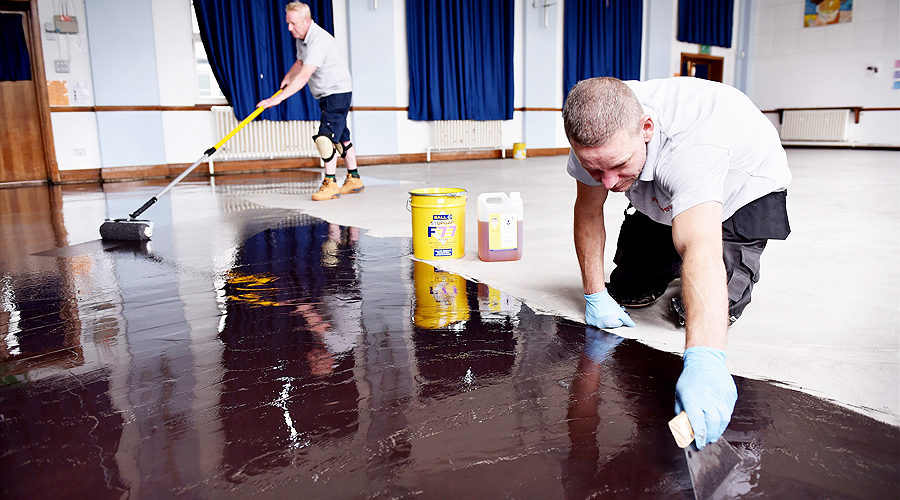Neil Sanders, Technical Service Director at one of the UK’s leading subfloor preparation products and flooring adhesives manufacturers, F. Ball and Co., provides a step-by-step guide on how to achieve a long-lasting professional flooring finish in educational settings.
F. Ball and Co. Ltd.
Subject to high levels of foot traffic, flooring in educational settings requires hardwearing characteristics to be able to withstand the demands placed upon it on a daily basis. With pressures to complete installations as quickly as possible, frequently requiring completion over a weekend or during a holiday, the latest fast-track subfloor preparation products and adhesives for floorcoverings have been designed to enable flooring contractors to do in a day what would have once taken a week.
Installing floorcoverings in any environment requires proper subfloor preparation to avoid the potential for floor failure, leading to costly recalls and remedial work. Before undertaking any flooring installation, a thorough assessment of the subfloor should be completed to ensure it is sound and free of dust and contaminants. Damaged subfloors should be repaired with an appropriate floor repair compound.
If the subfloor is a newly-installed screed, laitance – a crust of fine aggregates and cement formed on the surface of the screed as it dries – may still be present, and floors that are being refurbished may be contaminated with old adhesive residues. To avoid costly floor failure, both laitance and contaminants should be mechanically removed before proceeding with a flooring installation.
The floor’s intended use should then be taken into account as this will inform the choice of products used. In an education setting, it is likely that it will be expected to endure high volumes of daily foot traffic, whilst remaining secure and hygienic.
Safeguarding against moisture
Unmanaged moisture, whether residual construction moisture or rising damp, is one of the leading causes of floor failure, causing adhesives to de-bond, carpet underlays to rot, wooden floors to warp, and resilient floorcoverings to blister – all of which have the potential to form a trip hazard. It can also lead to the movement of floorcoverings and the growth of mould and bacteria, which can potentially cause a health risk to people in the immediate environment. For these reasons, F. Ball recommends that a moisture measurement test is conducted as part of any flooring installation.
The method of moisture measurement advocated by British Standards is to use a pre-calibrated hygrometer. If subfloor relative humidity (RH) levels exceed 75%, or 65% when installing wooden floorcoverings, a moisture management solution will be required to stop excess subfloor moisture damaging floorcoverings and adhesives and potentially causing floor failure.
Liquid waterproof surface membranes are the usual moisture management solution. The best-performing epoxy waterproof surface membranes will isolate excess subfloor moisture where RH values are up to 98%, with a single-coat application, which will fully cure in as little as three hours.
Quicker, two-coat systems are available that will create an effective barrier against residual construction moisture where RH values are up to 95%. The first coat cures in 15 to 20 minutes, and a further 30 minutes curing time is required for the second coat.
Prime importance
Once the subfloor is sound, smooth and dry, or a suitable moisture management solution is in place, it will be essential to prime the subfloor in almost all circumstances to promote adhesion of a levelling compound and prevent levelling compounds and adhesives drying too rapidly.
A levelling compound should then be applied to create a perfectly smooth surface for new floorcoverings. In some areas of schools, colleges and universities, such as corridors, floors will be expected to receive high levels of daily foot traffic, so using a high-strength levelling compound is recommended to help ensure long-term durability of the installation.
Fast-track levelling compounds that are ‘walk-on’ hard in 30 minutes and ready to receive new floorcoverings from 45 minutes are also available, allowing installations to proceed faster than ever.
In education facilities, it is important to select levelling compounds that are low odour and protein-free, this ensures they are suitable for the most sensitive environments.
High-performance levelling compounds that can be applied directly over bitumen and adhesive residues also offer significant timesaving benefits for contractors undertaking refurbishment projects to a deadline. One such product, F. Ball and Co.’s Stopgap 1200 Pro, takes as little as 60 minutes to set and is ready to receive floorcoverings from as little as four hours.
Choosing the right adhesive
Once the levelling compound has cured, the contractor can then select a suitably fast-working adhesive to install appropriate floorcoverings. The choice of adhesive will often be determined foremost by what type of floorcoverings are to be installed and where, but there are options for when timesaving is a priority.
For carpet tiles, tackifiers are available that only take 30 minutes to form a permanently tacky film, which will prevent tiles from moving laterally under everyday traffic, while allowing individual sections to be easily lifted and replaced if damaged or worn.
Fast-track adhesives designed for the installation of vinyl floorcoverings are also available, building up a bond strong enough to allow for foot traffic in less than an hour after the application of floorcoverings. For example, F. Ball’s Styccobond F58 PLUS is a fibre-reinforced, pressure-sensitive adhesive with a fast-drying formulation that enables vinyl sheet, tiles and planks to be secured from just five minutes following application of the adhesive. As well as helping to reduce movement during installation, the product’s high-bond strength and strong initial tack also prevents excess adhesive oozing between joints, facilitating easier application.
A final note on adhesive selection: it is always advisable to check the compatibility of particular floorcoverings and adhesives to ensure against floor failure. For this purpose, F. Ball produces a Recommended Adhesives Guide (RAG), which lists adhesives recommended for use with over 6000 floorcoverings produced by over 200 manufacturers. A continuously-updated version of the RAG is available as a free app and on the F. Ball website.










